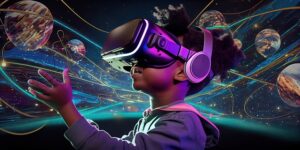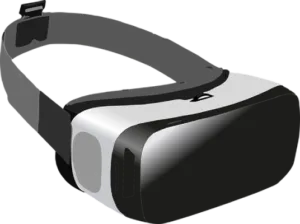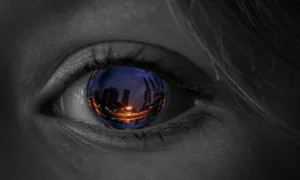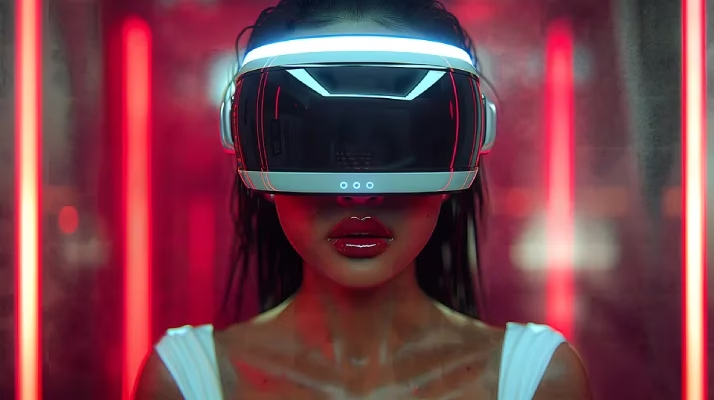The Gateway to Immersive Experiences
Imagine stepping into a world where the boundaries between reality and imagination blur, where the limits of human experience are pushed far beyond what was once thought possible. This is the captivating realm of virtual reality (VR), a groundbreaking technology that has the power to transport users into fully immersive, computer-generated environments.
Through the use of specialized headsets and sensory devices, VR creates the illusion of being whisked away to a completely different world, one that is crafted entirely by the power of modern computing and human ingenuity. At its core, virtual reality offers an escape from the confines of our physical existence, allowing us to explore and interact with digital realms that defy the laws of physics and challenge our very perception of reality.

Whether it’s soaring through the skies like a bird, traversing the depths of the ocean without getting wet, or even experiencing the thrill of space travel, VR opens up a universe of possibilities that were once confined to the realm of imagination.
The Science Behind the Magic
But how does this technological marvel work its magic? At the heart of any VR system is a headset that serves as the gateway to the virtual realm. These headsets typically feature two high-resolution displays, one for each eye, that create a stereoscopic 3D image. This image is carefully engineered to mimic the way our eyes perceive depth and perspective in the real world, creating a sense of immersion that tricks our brains into believing that the virtual environment is real.
However, VR doesn’t stop at just engaging our sense of sight; it aims to engage all of our senses in order to create a truly believable and immersive experience. Advanced VR systems incorporate spatial audio, which simulates sound coming from different directions, adding an extra layer of realism to the experience. Imagine being able to hear the roar of a virtual waterfall as if it were right next to you, or the distant rumble of a thunderstorm on the horizon.

Furthermore, some cutting-edge VR systems even incorporate haptic feedback, which creates tactile sensations that correspond to the virtual environment. This technology can simulate the sensation of touching a virtual object, feeling the rumble of an explosion, or even the resistance of swinging a virtual sword. By engaging multiple senses simultaneously, VR creates a level of immersion that was once thought impossible, transporting users to entirely new worlds and experiences.
Limitless Possibilities in Entertainment and Beyond
While the concept of virtual reality may seem like something straight out of a science fiction novel, its applications are already being explored and embraced across a wide range of industries. Perhaps one of the most obvious and exciting applications of VR is in the realm of entertainment, where it has the potential to revolutionize the way we experience movies, video games, and other forms of media.
Imagine being able to step inside your favorite video game, battling monsters and exploring fantastical worlds as if you were truly there. No longer are you confined to a screen or controller; with VR, you become fully immersed in the action, able to look around and interact with the virtual environment in a way that was previously unimaginable.
Similarly, VR has the potential to transform the way we experience films and other forms of storytelling. Instead of passively watching a movie on a screen, VR allows you to become an active participant in the narrative, with the ability to explore and experience the story from different perspectives. This opens up a new realm of artistic expression and storytelling possibilities that could redefine the way we consume and engage with media.
But the applications of virtual reality extend far beyond mere entertainment. In the field of education, VR is being used to create interactive learning experiences that engage students in ways that traditional classroom settings cannot. Students can take virtual field trips to historical sites, explore the inner workings of the human body, or even conduct simulated experiments in a virtual laboratory. This hands-on, immersive approach to learning has the potential to revolutionize the way we educate and train the next generation of professionals and scholars.
Transforming Training and Therapy
In the medical field, VR is proving to be a valuable tool for training surgeons and other medical professionals. By simulating complex surgical procedures in a virtual environment, doctors and nurses can practice and hone their skills without putting real patients at risk. This not only improves the quality of training but also has the potential to save lives by reducing the risk of human error during actual procedures.

Moreover, VR is being explored as a potential therapy for a variety of mental and physical conditions. For individuals suffering from anxiety, post-traumatic stress disorder (PTSD), or phobias. VR can provide a safe and controlled environment in which to confront their fears and work through their challenges. By gradually exposing patients to simulated scenarios that trigger their specific anxieties or fears, therapists can help them develop coping mechanisms and desensitize themselves to these triggers over time.
Similarly, VR is being used in the field of chronic pain management, offering an alternative or complementary approach to traditional pain medication. By immersing patients in calming virtual environments or engaging them in distracting tasks or activities. VR has the potential to redirect their focus away from their pain and provide a sense of relief or respite.
Revolutionizing Collaboration and Communication
But the impact of virtual reality is not limited to individual experiences. It also has the potential to revolutionize the way we collaborate and communicate on a global scale. Imagine attending a virtual conference or meeting, where participants from around the world can come together. In a shared virtual space, eliminating the need for costly and time-consuming travel.
In these virtual environments, attendees can not only see and hear each other as if they were in the same physical location. But they can also interact with virtual whiteboards, presentations, and other collaborative tools. This opens up new possibilities for remote collaboration and knowledge sharing. Breaking down geographical barriers and fostering a more connected and efficient global workforce.
Furthermore, VR has the potential to transform the way we communicate on a personal level. Virtual social platforms and environments could allow friends and families to come together in shared virtual spaces. Creating a sense of togetherness and connection that transcends physical distance.
READ ALSO
Overcoming Challenges and Ethical Considerations
Despite the immense potential of virtual reality, it is important to recognize that this technology is still in its relative infancy. There are challenges and ethical considerations that must be addressed as it continues to evolve and become more widespread.

One of the most significant challenges facing VR is the potential for motion sickness or discomfort. Which can arise from the disconnect between the visual cues provided by the headset and the physical sensations experienced by the user’s body. Researchers and developers are actively working to mitigate these issues through improved hardware and software solutions. But it remains a hurdle that must be overcome to ensure a comfortable and enjoyable VR experience for all users.
Additionally, there are concerns regarding the cost and accessibility of high-quality VR systems. While the technology has become more affordable in recent years, the hardware and software required for a truly immersive VR experience can still be prohibitively expensive for many consumers and organizations. As the technology continues to mature and become more mainstream, it will be important to address these accessibility issues to ensure that the benefits of VR are not limited to only a select few.
Ethical Considerations
Furthermore, there are ethical considerations surrounding the use of virtual reality. Particularly, regarding the potential for misuse or abuse. As VR becomes more realistic and immersive, there are concerns. About the impact it may have on users’ perceptions of reality. As well as the potential for virtual environments to be used for nefarious purposes. Such as the creation of virtual spaces that promote harmful or illegal behavior.
Additionally, the collection and use of user data in virtual environments raises privacy concerns. Moreover, VR systems may have the ability to track and monitor user behavior and biometric data. In ways that could be invasive or exploitative if not properly regulated and safeguarded.

It is crucial that as VR technology continues to advance. These ethical and societal implications are carefully considered and addressed through robust policies, regulations, and ethical guidelines. By proactively addressing these concerns. We can ensure that the immense potential of virtual reality is harnessed responsibly and beneficially for all.
The Future is Virtual
As we stand on the precipice of a new era of virtual reality. It is clear that this technology has the potential to reshape our understanding of reality. And push the boundaries of human experience in ways that were once unimaginable. From entertainment and education to training and therapy. The applications of VR are vast and far-reaching, offering a gateway to limitless possibilities.
As we continue to explore this uncharted territory. We can expect to see even more remarkable and innovative uses of VR that will challenge our perceptions. And redefine the way we live, work, and interact with the world around us. The future is virtual, and the only limit is the boundless expanse of our own imagination and creativity.
In the end, virtual reality is not just a technological marvel. It is a transformative force that has the power to transcend the physical constraints of our world. And unlock the full potential of human ingenuity. As we embrace this technology and navigate its challenges and ethical considerations. We inch closer to a future where the lines
References:
- “The History of Virtual Reality” – Virtual Reality Society, https://www.vrs.org.uk/virtual-reality/history.html
- “The Future of Virtual Reality: Trends, Opportunities, and Challenges” – IEEE Computer Society,
- “The Ethics of Virtual Reality” – Stanford Encyclopedia of Philosophy,
- Virtual Reality – VR Wikipedia

